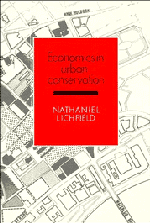Book contents
- Frontmatter
- Contents
- List of diagrams, tables and plans
- Preface
- Acknowledgements
- Introduction
- Part I Planning and management in the conservation of the urban system
- Part II Conservation of the cultural built heritage
- Part III Economics in urban conservation
- 7 Economics in the management of the built environment
- 8 Economics in the conservation of the CBH
- 9 Economics in planning for conservation of the CBH
- 10 Valuation of the cultural built heritage
- 11 Screening of the inventory or list
- 12 Who benefits and who loses from conservation of the CBH?
- Part IV Selected tools of economic analysis for project evaluation
- Part V Case studies in the economics of conservation of the CBH
- Notes
- Bibliography
- Index
7 - Economics in the management of the built environment
Published online by Cambridge University Press: 10 November 2010
- Frontmatter
- Contents
- List of diagrams, tables and plans
- Preface
- Acknowledgements
- Introduction
- Part I Planning and management in the conservation of the urban system
- Part II Conservation of the cultural built heritage
- Part III Economics in urban conservation
- 7 Economics in the management of the built environment
- 8 Economics in the conservation of the CBH
- 9 Economics in planning for conservation of the CBH
- 10 Valuation of the cultural built heritage
- 11 Screening of the inventory or list
- 12 Who benefits and who loses from conservation of the CBH?
- Part IV Selected tools of economic analysis for project evaluation
- Part V Case studies in the economics of conservation of the CBH
- Notes
- Bibliography
- Index
Summary
Conservation in economic life
What is economic life?
In his everyday activities, as an individual or in a family or wider group, man has many different lives, spiritual, cultural, social, psychological, physiological as well as economic. The lives are concurrent and interdependent: religious activity needs financial resources for maintaining the religious establishment and places of worship; cultural activities need a social framework; physiological well being is very much influenced by employment and income.
Within this array of diverse lives, economic life has one special characteristic. The implementation of any decision to act in any of the lives typically implies the use of economic resources, natural or man-made, for without them the decision will not result in action. Even daily meditation or jogging absorbs time which could be put to competing purposes. It is in this way that economic life penetrates all other lives. We now turn to how this takes place.
‘Economic life is an organisation of producers to satisfy the wants of consumers.’ It enables people to exchange, typically via the means of money, the output of their production (as owner of one of the classical factors of land, capital, labour or entrepreneurial/management skills) for the goods and services they consume. In the private sector the money typically comes from private income or capital. In the public sector the money is typically owned collectively, in that it is raised from taxes.
- Type
- Chapter
- Information
- Economics in Urban Conservation , pp. 117 - 144Publisher: Cambridge University PressPrint publication year: 1989



